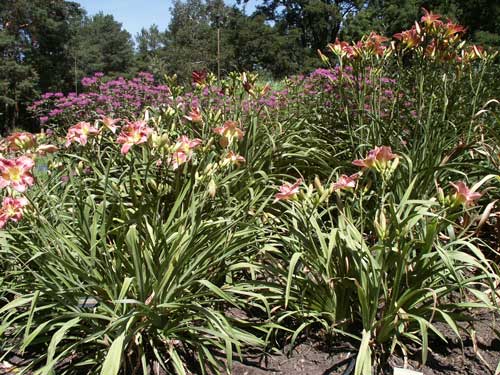A daylily is an easy-to-grow perennial
Daylilies are easy-to-grow perennials, meaning they return year after year. They belong to the genus Hemerocallis, from the Greek, meaning “beauty for a day.”

Above: Daylily clumps often have arching foliage and come in a wide range of heights.
Each bloom lasts for just one day. However, an established daylily clump has many flower stems (called scapes), with many buds, providing blooms on each plant for many days.
The incredible variety in size, color, and form of the modern dayliliy is amazing!
How a daylily grows
The crown, located between the roots and the foliage, is the heart of the daylily, functioning as its essential growth center. Most daylilies must have a piece of the crown (along with some roots and foliage) to grow; a daylily does not naturally grow from a piece of true root or from a leaf cutting. Daylilies do not grow from bulbs. Some daylilies (typically species or “wild” types) form rhizomes that can produce a new plant. Rhizomes have scales and internodes, while true roots do not. Most modern cultivars do not form rhizomes.
Roots vary in shape and thickness, and they generally grow more downward than out. Enlarged or thickened parts of the roots are thought to be for water storage.
A daylily's strap-like leaves emerge directly from the crown and grow in an arching or fountain-shape clump. (This is one way to distinguish a daylily from a “true” lily, i.e., Lilium, which has whorls of stemmed foliage at intervals on a stalk.)
Scapes (flowering stems), initiate from the crown and form branches and buds for flowering. Scape heights range from 12" to 60" or taller.
Modern daylilies do not grow true from seed. The offspring from seeds will usually look quite different from either of the parent plants.
To be true to name, a daylily needs to be grown from a piece of the original plant. The usual process is to dig a mature plant and make divisions. To be viable, a division must include part of the crown, part of the root system, and part of the upper foliage. (Note that a piece of rhizome may also produce a new daylily plant for those types that produce rhizomes).
Double fans and single fans
A division with two sets of fans is called a double fan (df). Loon Song Gardens ships double fans unless otherwise indicated. Availability of some daylilies may be very limited, and these will be sold as a single fan (sf). Our plant list clearly indicates which daylilies are available as single fans only.
Sleep, creep, and leap
Your new daylilies should bloom the year after planting. Spring-planted divisions may bloom the first summer, but many daylilies need at least one full season to recover and establish before blooming.
Some daylilies (especially spiders and unusual forms) need more time to establish than others. These are said to “resent division.” If you see this notation for a daylily you buy, try to avoid moving it after planting, and if you do, be patient while it re-establishes.
There is a saying among northern daylily growers: First year sleep, second year creep, third year leap.
You should see signs of growth during the first year, but the plant will not increase much in size or in number of fans. By the third year, if the daylily is suited to your climate and growing conditions, it should have multiple fans and put on a good show.
You do not need to divide most daylilies to encourage blooming, and a large clump in full bloom can be breathtaking! However, consider division if you notice a decline in bloom. You may also want to divide a clump to reduce its size, to create more plants for your garden, to share with friends and neighbors, to donate to an auction, or to sell.
What about tissue cultured daylilies?
Daylilies may be propagated by tissue culture and grown on for the mass market. This laboratory technique involves creating large numbers of exact clones from tiny pieces of the original plant and growing them under sterile conditions. Due to supply and demand, tissue culture can dramatically reduce the price for an otherwise expensive new daylily.
Many daylily growers are distrustful of tissue cultured clones, because problems have occurred with mislabeling, poor quality, and small size plants that take a long time to establish and bloom. In addition, there are daylilies that do not seem to clone successfully. If the process is successful, a tissue cultured daylily should be exactly the same as the parent, but you should be aware of potential problems, especially if you plan to use the plant for hybridizing. Loon Song Gardens sells only field grown daylilies.
For additional information, see More about Daylilies.

